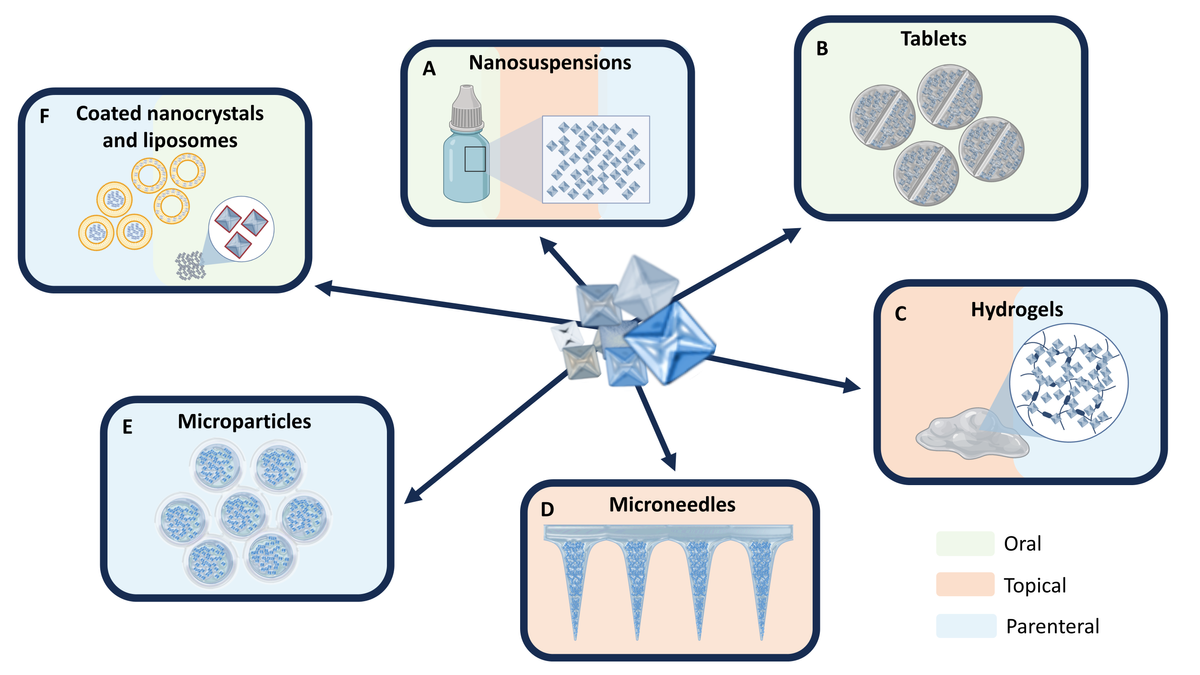Nanocrystals and nanosuspensions: an exploration from classic formulations to advanced drug delivery systems

Nanocrystals and nanosuspensions have become realistic approaches to overcome the formulation challenges of poorly water-soluble drugs. They also represent a less-known but versatile platform for multiple therapeutic applications. They can be integrated into a broad spectrum of drug delivery systems including tablets, hydrogels, microneedles, microparticles, or even functionalized liposomes. The recent progresses, challenges, and opportunities in this field are gathered originally together with an informative case study concerning an itraconazole nanosuspension-in-hydrogel formulation. The translational aspects, historical and current clinical perspectives are also critically reviewed here to shed light on the incoming generation of nanocrystal formulations.
1. Introduction
Nanocrystals and nanosuspensions are crystalline or partly amorphous nano-sized structures of active compounds obtained through two main methods: one involves size reduction of larger crystals mainly by milling or high-pressure homogenization techniques (known as the top-down approach), whereas the other involves precipitation of dissolved molecules mainly by crystallization or spray-drying (referred to as the bottom-up approach) [5, 6]. One of their significant and well-known advantages is their high specific surface area. According to the Noyes-Whitney equation, this favors a faster dissolution; and additionally an increased saturation concentration (Freundlich-Ostwald relation) [7, 8]. This, together with a very high drug loading, and a nanosized particle distribution has promoted their implementation in formulation development [4, 9]. Taking advantage of these assets, formulation scientists have been mainly focused on improving the oral bioavailability of poorly water-soluble drugs over the last two decades [6, 9–11]. Literature inputs various reports on this application with particular emphasis on the formulation methodology and solid-state characterization of nanocrystals (see for instance the following review articles [6, 12, 13]). However, there exists nowadays a growing interest in exploring other opportunities. This not only entails other administration routes but also a search for alternative strategies to improve current treatments lacking efficacy. Nanocrystals or nanosuspensions represent in fact a less known but versatile platform for multiple applications. They possess a high particle engineering potential and can be linked to a broad spectrum of drug delivery systems (Fig. 1).
This review article aims to provide an up-to-date, comprehensive, and cross-disciplinary overview of some of the latest improvements in the field of nanocrystal technology for different applications. Particular attention is given for the first time to their integration in different drug delivery systems, ranging from classic nanosuspensions or tablet formulations to novel microneedles or targeted nanocrystals. In order to illustrate further the potential of these approaches, and the technicalities, we have included an informative and original case study dealing with the formulation and characterization of a nanosuspension-hydrogel of the poorly water-soluble drug itraconazole. To conclude, the historical and current perspectives in the clinic are addressed. The section contains a critical view with relevant information about the challenges and opportunities of these technology approaches. All the insights gathered will help researchers, formulators, and clinicians to comprehend better their current translational reality.
Download the full study pre-print as PDF here: Nanocrystals and nanosuspensions: an exploration from classic formulations to advanced drug delivery systems – pre print
or read it here
Benjamin Rossier, Olivier Jordan, Eric Allémann et al. Nanocrystals and nanosuspensions: an exploration from classic formulations to advanced drug delivery systems, 30 November 2023, PREPRINT (Version 1) available at Research Square
https://doi.org/10.21203/rs.3.rs-3621399/v1

